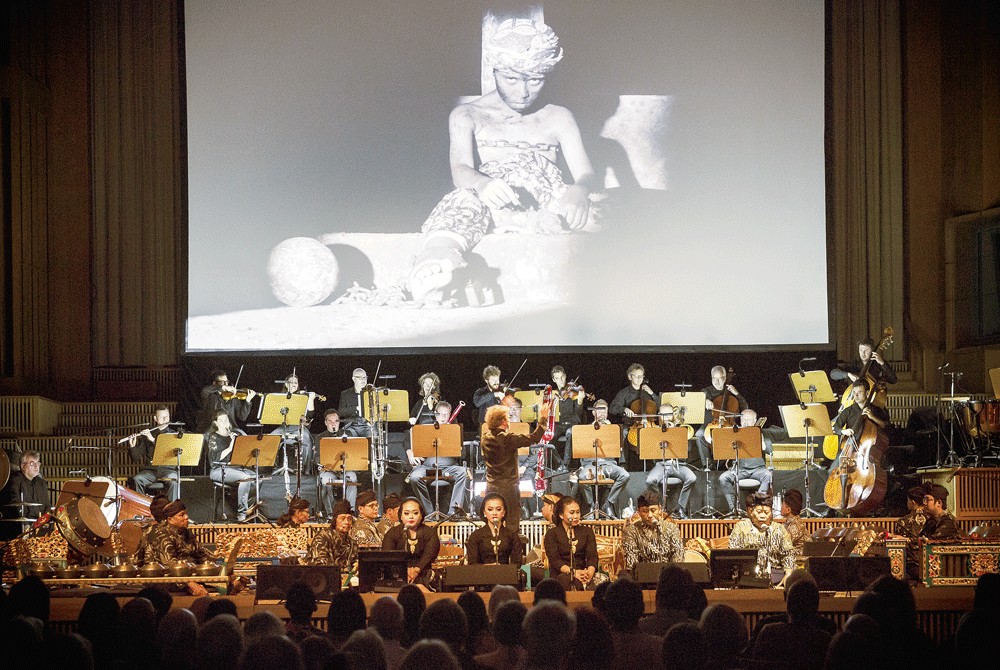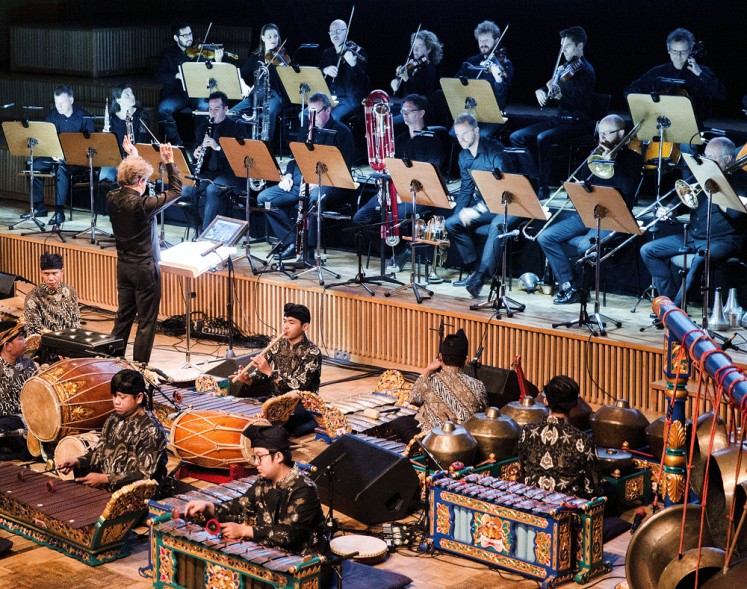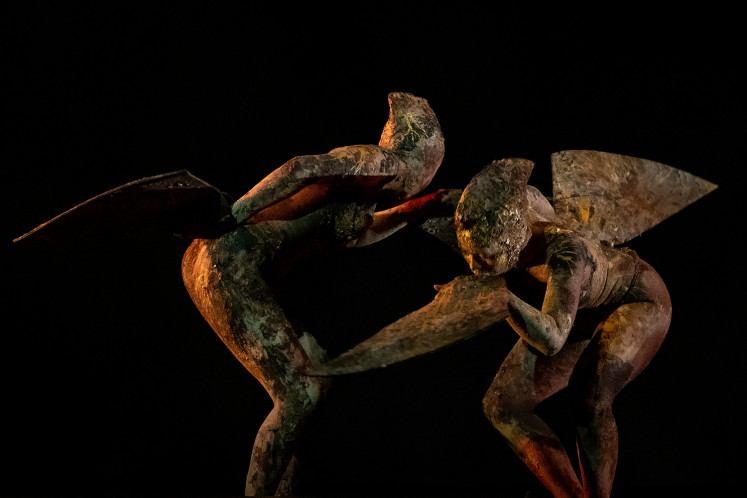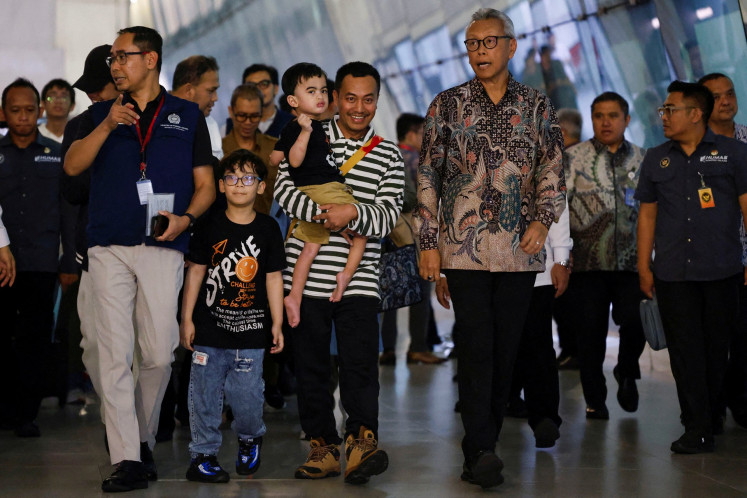Popular Reads
Top Results
Can't find what you're looking for?
View all search resultsPopular Reads
Top Results
Can't find what you're looking for?
View all search results'Setan Jawa': A celebration of image and sound
The first black-and-white silent film by celebrated Indonesian director and producer Garin Nugroho, Setan Jawa (The Javanese Devil), was screened in Germany, accompanied by the Garasi Seni Benawa gamelan orchestra and the Berlin Radio Symphony Orchestra.
Change text size
Gift Premium Articles
to Anyone
 Fresh touch: Garin Nugroho’s silent film, Setan Jawa (The Javanese Devil), is screened with a live orchestra in Berlin. (Fourtesy of Stiftung Humboldt Forum im Berliner Schloss/David von Becker)
Fresh touch: Garin Nugroho’s silent film, Setan Jawa (The Javanese Devil), is screened with a live orchestra in Berlin. (Fourtesy of Stiftung Humboldt Forum im Berliner Schloss/David von Becker)
S
etio, a young poor man, falls in love with Asih, a beautiful aristocrat, but the woman’s family rejects his marriage proposal because of his lowly status. Despairing, he makes a deal with the devil so he can spend the rest of his life with the woman he loves, but his pact comes at a high price.
This is the premise of Garin Nugroho’s stunning silent film Setan Jawa (The Javanese Devil), set in the early 20th century when Indonesia was still under Dutch colonial rule. The film was recently screened in Berlin to the live accompaniment of the Garasi Seni Benawa gamelan ensemble and the Berlin Radio Symphony Orchestra.
Setan Jawa celebrated its world premiere in February 2017 to great success on the opening night of the Asia Pacific Triennial of Performing Arts, held at Australia’s Melbourne Art Centre.
Garin’s multilayered masterpiece contains many important and noteworthy elements: Setan Jawa is the celebrated director’s first black-and-white film, inspired by great silent film classics such as FW Murnau’s Nosferatu ( 1922 ) and Fritz Lang’s Metropolis ( 1927 ). Another novelty is the East-meets-West approach that brings together a Javanese gamelan ensemble and a symphony orchestra.
“To me, being able to show Setan Jawa in Berlin feels a little bit like [coming home],” said Garin. “This film was inspired both by wayang kulit and the silent movies from Germany, which I think is the home of this genre.”
Indeed, the combination of German Expressionist films with Javanese mysticism results in a unique onscreen interpretation.
Setan Jawa touches on many different topics like colonialism, magical realism, pesugihan (making a deal with the devil to fulfill one’s desires) and sensuality, which are brought to life by the phenomenal actors — many of whom are also professional dancers — through mere facial expressions and physical movements.
Rahayu Supanggah and Iain Grandage from Australia created the music for the film.

“The core of my composing practice is to collaborate with other artists,” Grandage said when asked about the unusual project. “Garin filmed in an extraordinarily short time, and Rahayu Supanggah had created a score — of course, in collaboration with Garin. This score [contains] three levels, namely Central Javanese, East Javanese and Balinese music, and I responded to that accordingly.”
When asked how it felt to work on the project as an “outsider”, Grandage said that Garin’s clear direction and descriptions on the different layers in the film that helped lead the orchestra to becoming an integral part of the production.
“I personally never felt more welcome in the creative process,” he explained. “By removing any sense of self from my own contribution, my own ego, I was able to offer more.”
What at first sounds like an alien concept — combining classical Western music with Javanese gamelan — transforms into an intriguing pairing. The Berlin Radio Symphony Orchestra complemented Garasi Seni Benawa perfectly, never once drowning out the soft and velvet sound of the gamelan ensemble’s gongs, xylophones and metallophones, and instead added moments of drama and tension, especially during the film’s most intense scenes.
The film screening and live performance, organized by Berlin’s Humboldt Forum, concluded the exhibition “[sound] Listening to the World”, which explored the world of sound and attracted more than 90,000 visitors over the course of six months.
“This concert hall already hosted many performances, but tonight’s event is a premiere even for this prestigious location, where artists from Indonesia, Australia and Berlin make music together,” said Hartmut Dogerloh, the Humboldt Forum’s general director, adding that the Berlin Radio Symphony Orchestra was well known for its fondness for experimenting with different musicians and various sounds.
Garin wants to take Setan Jawa to China next, where he plans to collaborate with a Chinese orchestra.
“Mysticism is the biggest source of humanity and of all art forms,” Garin said. “If you create a film with [a mystical soul], it means that we can bring this movie to many different countries where different composers can provide their own interpretations and make new compositions, adding various perspectives to Setan Jawa and create an ever bigger exchange.”









